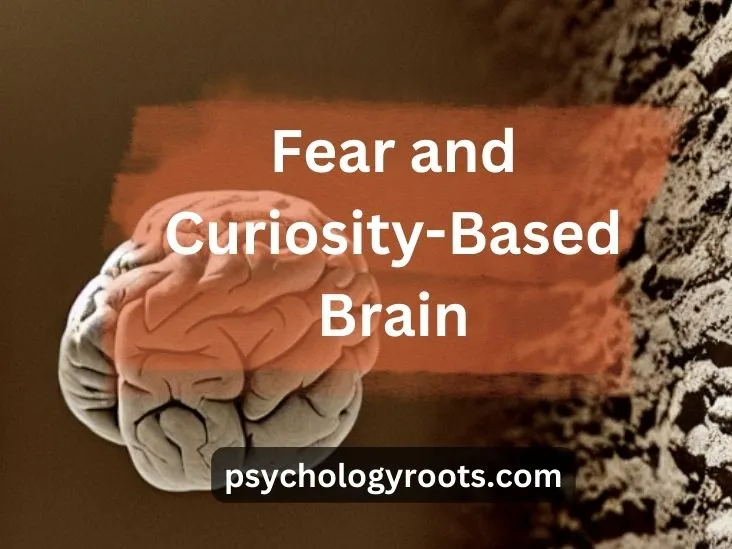Table of Contents
Fear and Curiosity-Based Brain
Here in this post, we are discussing “Fear and Curiosity-Based Brain”. You can read more about psychology-related material on our website. Keep visiting Psychology Roots.
Our brain is capable of performing tasks as diverse as solving mathematical conundrums, writing fine poetry, skating after a hockey puck, or wielding a steak knife with an elegance and precision that took a million years of non-stop mutations, or evolutionary trial-and-error, to achieve. These abilities allow us to do things like solve mathematical conundrums, write fine poetry, skate after a hockey puck, or wield a steak knife.
However, despite all of its sophistication and efficacy, the brain is also a hodgepodge collection that contains antiquated structures. The characteristics of these structures dictate our lives and often make them worse.
It is essential to emphasise the fact that due to the enormous and poorly understood complexity of the brain, there is no one part of its structure that is solely responsible for any one pattern of behaviour. Instead, the organ functions more like a miniature Rembrandt (or Jackson Pollock, perhaps), drawing from the diverse colours and textures of the synaptic palette in order to create the image of a single thought or action.

Nevertheless, researchers have been able to establish an approximate association between some broad elements of behaviour and brain regions that are considerably more involved in these qualities than other centres via the use of functional MRI technology. The interplay between two critical regions of the brain that are important in human behaviour, namely the amygdala and the hippocampus, is one of the clearest examples of this fact.
The structure known as the hippocampus is evidently engaged in the process of memory storage, as well as performing tasks related to spatial navigation and creative curiosity. In what is most certainly the direct outcome of those million years of hunting, gathering, and migrating, the hippocampus region — in close conjunction with the prefrontal cortex — seems to solidify memories of events depending on the external places in which they took place. Then, in a satisfyingly cyclical reiteration of that navigational ability, it maps those regions of the brain in which the memories are kept in order to allow for the memories to be recalled and connected with other memories and events.
It is tempting to speculate that the processes of navigation and memory, both internal and external, eventually turned into a parallel synaptic architecture, which enables our curiosity and imagination, because they were so crucial in facilitating the explorations of our proto-human and human ancestors. This is because they were so important in facilitating the explorations of our proto-human and human ancestors. Curiosity and exploration are two activities that seem to be closely connected to increased activity in the structure of the hippocampus region. This is something that can definitely be said to be the case.
The amygdala is another important part of the brain. However, it seems to be most directly involved in short-term fear and aggression responses, such as the fight-or-flight reflex, and in triggering the release of hormones needed to implement such reflexes. The amygdaloid body is located quite close to the hippocampus, and like that area, it is equally divided between the two hemispheres of the brain. It regulates multiple aspects of our emotions and communicates with both our sensory areas and the hippocampus in modulating those emotions
These reflexes, of course, were most helpful for fast-breaking, real-world situations that our ancestors encountered in the wild, risk-filled environment in which they hunted, gathered, and migrated. Our ancestors were constantly on the move, so they were constantly putting themselves in dangerous situations. The amygdala pumped in large amounts of stress hormones, such as adrenaline, epinephrine, and cortisol, which caused the pupils to widen and caused the body to reflexively freeze, sprint away, or attack. This most certainly saved our ancestors’ butts from crouching saber-toothed cats, stampeding buffaloes, and the ambush of hostile tribes.
However, obviously things are different now. Although there is one stray cat and a decent number of barking dogs on the street in Brooklyn where I am writing these words, the street does not have any saber-toothed cats or dogs. Aside from a few sad outliers, the vast majority of the world’s human population should not be too concerned about imminent threats to their physical safety or assaults on them while going about their regular lives. Fear and stress responses are still important in certain situations, such as when you are confronted by a potentially dangerous stranger on the subway or when you are walking along a country road and a car comes around a curve at high speed, but they are largely irrelevant in everyday life in today’s modern society.
Unless, of course, you’re running for office or working for one of the huge social media businesses that increasingly influence how a democracy runs. In both of those cases, you’ll need to pay attention to how the public perceives you.
Help Us Improve This Article
Have you discovered an inaccuracy? We put out great effort to give accurate and scientifically trustworthy information to our readers. Please notify us if you discover any typographical or grammatical errors.
Make a comment. We acknowledge and appreciate your efforts.
If you have any scale or any material related to psychology kindly share it with us at psychologyroots@gmail.com. We help others on behalf of you.